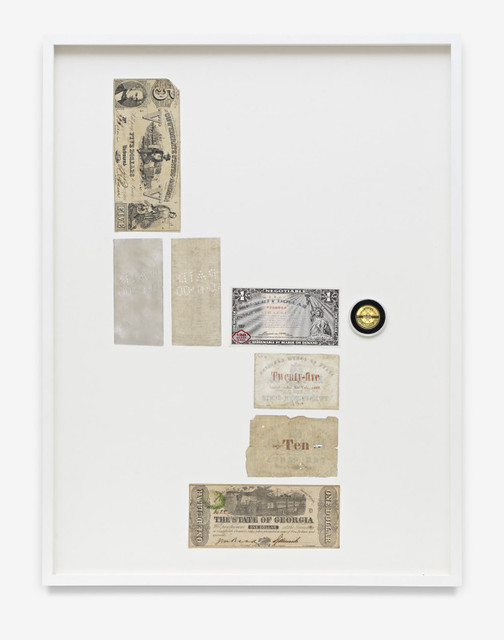
PREV ARTICLE
NEXT ARTICLE
FULL ISSUE
PREV FULL ISSUE
MONEY ARTIST BRAD TROEMEL EXHIBITIONAndrew Hurle writes: Readers may be interested in the subject of an exhibition by an American artist named Brad Troemel held at the Future Gallery in Berlin, Germany.

From the web site: Future Gallery is proud to present The Edwards Copy, 1796 – 2014 a solo exhibition of new work by American-artist Brad Troemel. From the years 1994 – 1999 I collected rare American coins and paper bills with my Grandpa. I used eBay to buy and sell counterfeit and authentic currencies produced during American colonial times and the Civil War. Did you know some people buy counterfeit currency on purpose? When a counterfeit is old, notorious, or done well enough, the historical value of the counterfeiter’s effort can meet or exceed the price of a United States’ Mint-produced coin or bill of the same date. Just like originals, counterfeits have histories too. All currencies -real and fake- eventually lose their exchangeability as money and become a collectable over time. You couldn’t spend an 1836 half cent at a store if you tried. Some counterfeits are made for historically illustrative purposes, displaying in perfect detail what money looked like hundreds of years ago. These educational counterfeits are branded COPY or FACSIMILE in very obvious ways. Unlike these, most counterfeits are attempts to appear real. When I made counterfeits to be sold on eBay I would try to blend in too, to be real. I would purchase educational counterfeits of colonial coins that were independently made in the 1780’s (prior to the Coinage Act of 1792 and subsequent creation of the Philadelphia mint). The first task would be to go to my driveway and use a brick to wear the coin down far enough so that the stamped COPY indentation was no longer visible. Next would be the chemical baths, alternating between Deller’s Darkener and a pencil eraser or EZ Brite, occasionally stopping between pourings to give the coin a few additional brick scuffs so to add layers of deepening chemical damage in an attempt to falsify the gradual process of copper’s deterioration. The chemical baths create an effect on the details of the coin not unlike if you were to alternately burn and dodge an image back and forth using Photoshop. These near-anonymous coins, in a deep state of wear and chemical damage, were barely legible save for a few defining details (I usually made sure at least the coin’s date remained intact). I sold batches of three or so of these coins at a time, with the auctions spread at least a month apart. All listings worked from an elaborate descriptive template where I said the coins were repossessed from the home of a dead Italian mobster and that due to the great deal of wear and tear they display it’s impossible to determine their authenticity, though it’s safe to assume the coins have a “dubious” provenance. At the end of the eBay description I would assure my faked obliviousness as a seller by professing to know nothing about coin history and restate that the coins were for sale “as is” because of my lack of knowledge. This would keep the door open for the hopeful who thought there was an outside chance of me being a rube and the coins being real, while for others the disclaimer would add an air of mystery as to what mob family counterfeited them and how many others were out there. My collectors were buying into a story and were receiving coins in exchange. My collectors were people interested in telling tales about the things in their collections. Marketable things can be fit into concise oral descriptions- like conceptual artworks!
"Faked obliviousness"??? Tell it to the magistrate - that's the biggest load of rubbish I've ever heard in my life. You're saying you're not really an eBay scammer because you were only PRETENDING to be an eBay scammer??? If you look like a crook, act like a crook, and take people's money like a crook, well, maybe you could put on a play for your fellow inmates at the prison Christmas pageant.
His eBay scams aside though, I think the Troemel's work as displayed here is legitimate and fully within the theme of modern "money artists" like J.S.G. Boggs. He discusses the Casascius Bitcoins and uses them in his work, along with other items we've discussed here in The E-Sylum, including NORFED coins and time-based community currencies. -Editor

To view the complete gallery online, see:
Brad Troemel
The Edwards Copy, 1796 – 2014
February 1 – 28, 2014
(futuregallery.org/present/brad-troemel-the-edwards-copy-1796-2014/)
The Numismatic Bibliomania Society is a non-profit organization promoting numismatic literature. See our web site at coinbooks.org. To submit items for publication in The E-Sylum, write to the Editor at this address: whomren@gmail.com To subscribe go to: https://my.binhost.com/lists/listinfo/esylum All Rights Reserved. NBS Home Page Contact the NBS webmaster 
|